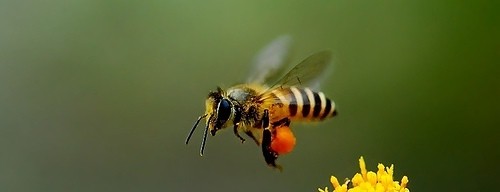Eastern honey bee
(Apis cerana)

Description
Apis cerana, the eastern honey bee, Asiatic honey bee or Asian honey bee, is a species of honey bee native to South, Southeast and East Asia. This species is the sister species of Apis koschevnikovi and both are in the same subgenus as the western (European) honey bee, Apis mellifera. A. cerana is known to live sympatrically along with Apis koschevnikovi within the same geographic location. Apis cerana colonies are known for building nests consisting of multiple combs in cavities containing a small entrance, presumably for defense against invasion by individuals of another nest. The diet of this honey bee species consists mostly of pollen and nectar, or honey. Moreover, Apis cerana is known for its highly social behavior, reflective of its classification as a type of honey bee. The terms Apis cerana indica and Apis Indica or Indian honey bee, is an historic term, with all Asian hive bees now referred to as Apis cerana. The physical characteristics of Apis cerana individuals are very similar to those of other species in the genus Apis. The individuals in this genus are defined by long, erect hairs that cover the compound eyes and assist in pollen collection, strongly convex scutellum, and a jugal lobe in the hindwing. Adult Apis cerana are black in color, with four yellow abdominal stripes. There are also distinctions between worker bees, queens, and drones. Worker bees are characterized by a pollen press on the hind leg to transport pollen, as well as a stinger in the place of an organ for laying eggs. Queens, which are the reproductive females, are typically larger than worker bees due to their enlarged reproductive organs. Drones, which are the males of the species, are defined by larger eyes, lack of a stinger, and a blunter abdominal shape. Apis cerana encompass a wide range of climatic zones including moist tropical rainforests, wet-dry tropical savannas, mid-latitude steppes, dry mid-latitude grasslands, moist continental deciduous forests, and taigas. The natural range of Apis cerana extends from Primorsky Krai in Russia in the north, to eastern Indonesia in the south; and to Japan in the east, to as far as the highlands of Afghanistan in the west. Countries they are native to include Afghanistan, Bangladesh, Bhutan, Brunei, Cambodia, China, India, Indonesia, Japan, Laos, Malaysia, Myanmar, Nepal, North Korea, Pakistan, the Philippines, Russia, South Korea, Sri Lanka, Taiwan, Thailand, Timor-Leste, and Vietnam.
Taxonomic tree:







